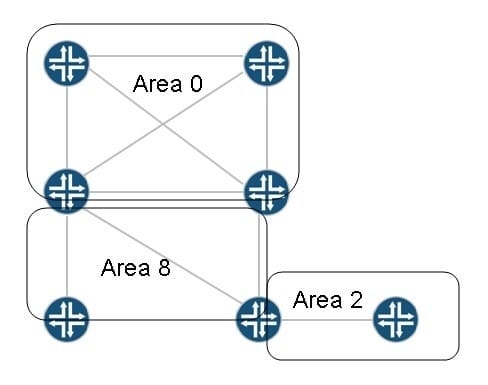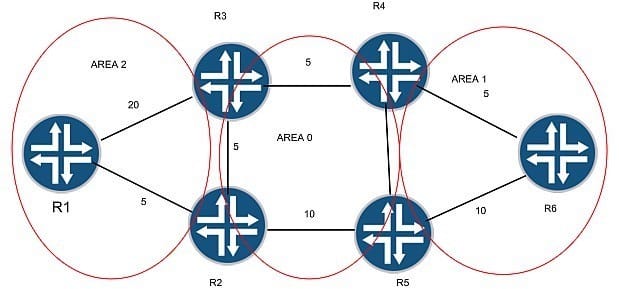Exam Details
Exam Code
:JN0-643Exam Name
:Enterprise Routing and Switching, Professional (JNCIP-ENT)Certification
:Juniper CertificationsVendor
:JuniperTotal Questions
:287 Q&AsLast Updated
:Jun 27, 2025
Juniper Juniper Certifications JN0-643 Questions & Answers
-
Question 101:
-- Exhibit -
Mar 16 17:48:06.145257 OSPF periodic xmit from 172.14.10.1 to 224.0.0.5 (IFL 69 area 0.0.0.1) Mar 16 17:48:12.404986 ospf_trigger_build_telink_lsas : No peer found Mar 16 17:48:13.013420 ospf_trigger_build_telink_lsas : No peer found Mar 16 17:48:13.013555 ospf_set_lsdb_statE. Router LSA 192.168.2.1 adv-rtr 192.168.2.1 state QUIET>GEN_PENDING Mar 16 17:48:13.013661 OSPF trigger router LSA 0x156d0f0 build for area 0.0.0.1 lsa-id 192.168.2.1 Mar 16 17:48:13.017494 ospf_set_lsdb_statE. Router LSA 192.168.2.1 adv-rtr 192.168.2.1 state GEN_PENDING->QUIET Mar 16 17:48:13.017636 OSPF built router LSA, area 0.0.0.1, link count 2 Mar 16 17:48:13.017954 OSPF sent Hello 172.14.10.1 -> 224.0.0.5 (ge-0/0/1.0 IFL 69 area 0.0.0.1) Mar 16 17:48:13.018023 Version 2, length 44, ID 192.168.2.1, area 0.0.0.1 Mar 16 17:48:13.018111 mask 255.255.255.0, hello_ivl 10, opts 0x2, prio 128 Mar 16 17:48:13.018162 dead_ivl 40, DR 172.14.10.1, BDR 0.0.0.0 Mar 16 17:48:13.018613 OSPF DR is 192.168.2.1, BDR is 0.0.0.0 Mar 16 17:48:13.018900 OSPF sent Hello 172.14.10.1 -> 224.0.0.5 (ge-0/0/1.0 IFL 69 area 0.0.0.1) Mar 16 17:48:13.018968 Version 2, length 44, ID 192.168.2.1, area 0.0.0.1 Mar 16 17:48:13.019032 mask 255.255.255.0, hello_ivl 10, opts 0x2, prio 128 Mar 16 17:48:13.019118 dead_ivl 40, DR 172.14.10.1, BDR 0.0.0.0 Mar 16 17:48:13.028426 OSPF DR is 192.168.2.1, BDR is 0.0.0.0 Mar 16 17:48:13.432025 OSPF packet ignoreD. area mismatch (0.0.0.0) from 172.14.10.2 on intf ge0/0/1.0 area 0.0.0.1 Mar 16 17:48:13.432135 OSPF rcvd Hello 172.14.10.2 -> 224.0.0.5 (ge-0/0/1.0 IFL 69 area 0.0.0.1) Mar 16 17:48:13.432189 Version 2, length 44, ID 192.168.5.1, area 0.0.0.0 Mar 16 17:48:13.432274 checksum 0x8065, authtype 0 Mar 16 17:48:13.432346 mask 255.255.255.0, hello_ivl 10, opts 0x2, prio 128 Mar 16 17:48:13.432398 dead_ivl 40, DR 172.14.10.2, BDR 0.0.0.0 commit complete -- Exhibit -
Click the Exhibit button.
Looking at the traceoptions output in the exhibit, why are the OSPF routers stuck in Init state?
A. There is an MTU mismatch.
B. There is a network mask mismatch.
C. The routers are in different areas.
D. No BDR has been elected.
-
Question 102:
-- Exhibit -
user@SwitchA# show protocols dot1x
authenticator {
authentication-profile-name dot1x;
interface {
ge-0/0/0.0 {
supplicant single;
}
ge-0/0/1.0 {
supplicant single-secure;
}
ge-0/0/2.0 {
supplicant multiple;
}
}
}
{master:0}[edit]
user@SwitchA# show access
radius-server {
172.27.14.226 {
port 1812;
secret "$9$vqs8xd24Zk.5bs.5QFAtM8X"; ## SECRET-DATA }
}
profile dot1x {
authentication-order radius;
radius {
authentication-server 172.27.14.226;
accounting-server 172.27.14.226;
}
accounting {
order radius;
immediate-update;
}
}
{master:0}[edit] user@SwitchA# -- Exhibit -
Click the Exhibit button.
Referring to the exhibit, which three statements describe correct behavior of Switch A? (Choose three.)
A. Switch A allows complete access to all users connected to port ge-0/0/2 that log in with their correct user credentials.
B. Switch A allows complete access to all users connected to port ge-0/0/0 that log in with their correct user credentials.
C. Switch A allows complete access to the second user that connects to port ge-0/0/1 with its correct credentials only after the first user logs out.
D. Switch A allows complete access to all users connected to port ge-0/0/0 without authentication after the first user has logged in with its correct user credentials.
E. Switch A allows complete access to all users connected to port ge-0/0/1 that securely log in using HTTPS with their correct user credentials.
-
Question 103:
-- Exhibit -
[edit protocols bgp]
user@router# show
group ext-peer2 {
type external;
peer-as 1;
neighbor 192.168.2.1;
}
[edit protocols bgp]
user@router# run show route 192.168.2.1
inet.0: 9 destinations, 10 routes (7 active, 0 holddown, 2 hidden) + = Active Route, - = Last Active, * = Both
192.168.2.1/32 *[Static/5] 00:01:56
> to 172.14.10.1 via ge-0/0/1.0
[edit protocols bgp]
user@router# run show bgp summary
Groups: 1 Peers: 1 Down peers: 1
Table Tot Paths Act Paths Suppressed History Damp State Pending inet.0 0 0 0 0 0 0 inet6.0 0 0 0 0 0 0
Peer AS InPkt OutPkt OutQ Flaps Last Up/Dwn State|
#Active/Received/Accepted/Damped...
192.168.2.1 1 0 0 0 0 14 Idle -- Exhibit -
Click the Exhibit button.

Looking at the output in the exhibit, why is the BGP neighbor not in Established state?
A. BGP Refresh is not supported.
B. Multihop is not configured.
C. The peer address is not reachable.
D. Authentication is configured.
-
Question 104:
-- Exhibit

-- Exhibit -
Click the Exhibit button.
In the exhibit, which statement about the ABR between Area 8 and Area 2 is true?
A. The router has connectivity to all areas.
B. The router has connectivity to Area 8 only.
C. The router has connectivity to Area 2 only.
D. The router has connectivity to all routers in Area 8 and Area 2.
-
Question 105:
-- Exhibit -
user@router> show class-of-service scheduler-map two Scheduler map: two, Index: 56974
Scheduler: sch-best-effort, Forwarding class: best-effort, Index: 26057 Transmit ratE. 1 percent, Rate Limit:
exact, Buffer sizE. remainder, Buffer Limit: exact, Priority: low Excess Priority: unspecified
Drop profiles:
Loss priority Protocol Index Name
Low any 1
Medium low any 1
Medium high any 1
High any 1
Scheduler: sch-expedited-forwarding, Forwarding class:
expedited-forwarding, Index: 10026
Transmit ratE. 1 percent, Rate Limit: none, Buffer sizE. 1 percent, Buffer Limit: none, Priority: high Excess Priority: unspecified
Drop profiles:
Loss priority Protocol Index Name
Low any 1
Medium low any 1
Medium high any 1
High any 1
user@router> show interfaces ge-0/0/1 extensive | find "CoS Information" CoS information: Direction : Output CoS transmit queue Bandwidth Buffer Priority Limit % bps % usec 0 best-effort 1 10000000 r 0 low exact 1 expedited-forwarding 1 10000000 1 0 high none
Logical interface ge-0/0/1.823 (Index 74) (SNMP ifIndex 506) (Generation 139) Flags: SNMP-Traps 0x4000 VLAN-Tag [ 0x8100.823 ] Encapsulation: ENET2 Traffic statistics: Input bytes : 1820224529 Output bytes : 6505980 Input packets: 1436371 Output packets: 75905
(... output truncated ...)
user@router> show interfaces ge-0/0/1 extensive | find "Queue Counters" Queue counters: Queued packets Transmitted packets Dropped packets 0 best-effort 1343970 1343970 7105 1 expedited-fo 53987 53987 2 assured-forw 0 0 3 network-cont 0 0 Queue number: Mapped forwarding classes 0 best-effort 1 expedited-forwarding 2 assured-forwarding 3 network-control Active alarms : None Active defects : None (... output truncated ...) -- Exhibit -
Click the Exhibit button.
Based on the configuration in the exhibit, why are you seeing drops in the best-effort queue on the SRX Series platform?
A. The drop-profile fill level is set too low.
B. Packets are dropped by a firewall policy.
C. The best-effort queue is being shaped.
D. The scheduler is not being applied correctly.
-
Question 106:
-- Exhibit -
Mar 16 18:39:15.800390 BGP RECV 172.14.10.2+57785 -> 172.14.10.1+179 Mar 16 18:39:15.800932 BGP RECV message type 1 (Open) length 59 Mar 16 18:39:15.800995 BGP RECV version 4 as 2 holdtime 90 id 192.168.5.1 parmlen 30 Mar 16 18:39:15.801064 BGP RECV MP capability AFI=2, SAFI=1 Mar 16 18:39:15.801112 BGP RECV Refresh capability, code=128 Mar 16 18:39:15.801172 BGP RECV Refresh capability, code=2 Mar 16 18:39:15.801224 BGP RECV Restart capability, code=64, time=120, flags= Mar 16 18:39:15.801289 BGP RECV 4 Byte AS-Path capability (65), as_num 2 Mar 16 18:39:15.801705 advertising receiving-speaker only capabilty to neighbor 172.14.10.2 (External AS 2) Mar 16 18:39:15.801787 bgp_senD. sending 59 bytes to 172.14.10.2 (External AS 2) Mar 16 18:39:15.801845 Mar 16 18:39:15.801845 BGP SEND 172.14.10.1+179 -> 172.14.10.2+57785 Mar 16 18:39:15.801933 BGP SEND message type 1 (Open) length 59 Mar 16 18:39:15.801991 BGP SEND version 4 as 1 holdtime 90 id 192.168.2.1 parmlen 30 Mar 16 18:39:15.802054 BGP SEND MP capability AFI=1, SAFI=1 Mar 16 18:39:15.802115 BGP SEND Refresh capability, code=128 Mar 16 18:39:15.802176 BGP SEND Refresh capability, code=2 Mar 16 18:39:15.802227 BGP SEND Restart capability, code=64, time=120, flags= Mar 16 18:39:15.802292 BGP SEND 4 Byte AS-Path capability (65), as_num 1 Mar 16 18:39:15.802615 bgp_process_caps: mismatch NLRI with 172.14.10.2 (External AS 2): peer:
(16) us: (1) Mar 16 18:39:15.802763 bgp_process_caps:2561: NOTIFICATION sent to 172.14.10.2 (External AS 2): code 2 (Open Message Error) subcode 7 (unsupported capability) value 1 Mar 16 18:39:15.802913 bgp_senD. sending 23 bytes to 172.14.10.2 (External AS 2) Mar 16 18:39:15.802969 Mar 16 18:39:15.802969 BGP SEND 172.14.10.1+179 > 172.14.10.2+57785 Mar 16 18:39:15.803057 BGP SEND message type 3 (Notification) length 23 Mar 16 18:39:15.803113 BGP SEND Notification code 2 (Open Message Error) subcode 7 (unsupported capability) Mar 16 18:39:15.803179 BGP SEND Data (2 bytes): 00 01 -- Exhibit -- Click the Exhibit button. Looking at the traceoptions output in the exhibit, why is the BGP neighbor not in Established state?
A. BGP refresh is not supported.
B. There is a router ID mismatch.
C. IPv6 is not supported on the local peer.
D. The peer AS number is misconfigured.
-
Question 107:
-- Exhibit -- Exhibit -

Click the Exhibit button.
Based on the SPF calculation in the exhibit, what is the shortest path to reach R3 from R1?
A. R2-R3
B. R2-R5-R4
C. R3
D. R2-R4
-
Question 108:
-- Exhibit -
{master:0}[edit]
user@switch# show ethernet-switching-options voip
interface ge-0/0/16.0 {
vlan phones;
}
{master:0}[edit]
user@switch# show interfaces ge-0/0/16
unit 0 {
family ethernet-switching {
port-mode access;
vlan {
members internet;
}
}
}
{master:0}[edit]
user@switch# show vlans
hr {
vlan-id 513;
}
internet {
vlan-id 15;
}
phones {
vlan-id 25;
}
servers {
vlan-id 30;
}
{master:0}[edit]
user@switch# show interfaces ge-0/0/23
description uplink;
unit 0 {
family ethernet-switching {
port-mode trunk;
vlan {
members [ hr internet ];
}
}
}
-- Exhibit -Click the Exhibit button.
You have recently implemented a Layer 2 network designed to support VoIP. Users have reported that they cannot use their IP phones to make calls.
Based on the switch configuration shown in the exhibit, which command will resolve this issue?
A. set interfaces ge-0/0/23 unit 0 family ethernet-switching vlan members phones
B. set interfaces ge-0/0/16 unit 0 family ethernet-switching port-mode trunk
C. set ethernet-switching-options voip interface ge-0/0/23 vlan phones
D. set vlans phones vlan-id 513
-
Question 109:
-- Exhibit

-- Exhibit -
Click the Exhibit button.
Referring to the exhibit, what is the correct RPF path toward the multicast source from R6?
A. R6-R5
B. R6-R7-R4-R5
C. R6-R4-R5
D. R6-R4-R3-R2-R5
-
Question 110:
-- Exhibit -
{master:0}[edit]
user@switch# show protocols vstp
vlan 100;
{master:0}[edit]
user@switch# run show spanning-tree bridge
STP bridge parameters
Context ID : 1
Enabled protocol : RSTP
STP bridge parameters for VLAN 100
Root ID : 32868.50:c5:8d:ae:94:80 Hello time : 2 seconds Maximum age : 20 seconds Forward delay : 15 seconds Message age : 0 Number of topology changes : 0 Local parameters Bridge ID : 32868.50:c5:8d:ae:94:80 Extended system ID : 1 Internal instance ID : 0 {master:0}[edit] user@switch# run show spanning-tree interface
{master:0}[edit] user@switch# -- Exhibit -
Click the Exhibit button.
Based on the output shown in the exhibit, why is VSTP not working for VLAN 100?
A. No interfaces are assigned to VLAN 100.
B. Your MSTI is misconfigured.
C. RSTP is configured in addition to VSTP.
D. No native VLAN is configured.
Related Exams:
JN0-102
Internet Associate, Junos(JNCIA-Junos)JN0-104
Junos, Associate (JNCIA-Junos)JN0-105
Junos, Associate (JNCIA-Junos)JN0-1101
Juniper Networks Certified Design Associate (JNCDA)JN0-1103
Design, Associate (JNCIA-Design)JN0-130
Juniper networks Certified internet specialist.e(jncis-e)JN0-1301
Data Center Design, Specialist (JNCDS-DC)JN0-1302
Data Center Design Specialist (JNCDS-DC)JN0-1331
Security Design, Specialist (JNCDS-SEC)JN0-1332
Security Design, Specialist (JNCDS-SEC)
Tips on How to Prepare for the Exams
Nowadays, the certification exams become more and more important and required by more and more enterprises when applying for a job. But how to prepare for the exam effectively? How to prepare for the exam in a short time with less efforts? How to get a ideal result and how to find the most reliable resources? Here on Vcedump.com, you will find all the answers. Vcedump.com provide not only Juniper exam questions, answers and explanations but also complete assistance on your exam preparation and certification application. If you are confused on your JN0-643 exam preparations and Juniper certification application, do not hesitate to visit our Vcedump.com to find your solutions here.